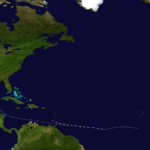The aftermath of Helene reveals a public health crisis as communities struggle for basic resources.
- Hurricane Helene caused extensive damage in western North Carolina, leaving thousands without water and power.
- Over 136,000 people are served by nonoperational water providers, with 1.8 million under boil water advisories.
- The storm resulted in significant fatalities and missing persons, making it one of the deadliest hurricanes since Katrina.
- Infrastructure damage is severe, complicating repair efforts in the mountainous terrain of the Blue Ridge Mountains.
- Federal officials are working to restore power and water, but many areas remain without basic services.
Nearly a week after Hurricane Helene wreaked havoc in western North Carolina, residents are still grappling with a severe shortage of drinking water. In downtown Asheville, a stainless steel tanker truck has become a lifeline for families, as people flock with containers to collect the precious resource. The hurricane’s flooding devastated the city’s water infrastructure, leading officials to warn that repairs could take weeks. Anna Ramsey, a local mother, shared her struggles, stating, ‘We have no water. We have no power. But I think it’s also been humbling.’ Helene’s impact extended beyond water shortages; it caused widespread power outages, with darkness so profound it was visible from space. The storm claimed over 200 lives, marking it as the deadliest hurricane to hit the U.S. mainland since Katrina in 2005, and hundreds remain unaccounted for. The Environmental Protection Agency reported that approximately 136,000 people are currently served by nonoperational water providers, while more than 1.8 million are under boil water advisories. The mountainous geography of the Blue Ridge complicates recovery efforts, as fewer roads and access points hinder the delivery of resources. Residents are yearning for basic amenities, with many expressing a longing for a simple shower. The floodwaters destroyed critical components of Asheville’s water system, necessitating extensive repairs. While some neighborhoods have regained water flow, full restoration is essential for schools, hospitals, and businesses to resume normal operations. The situation is dire, with officials warning of a public health emergency due to the lack of sanitation. Even in areas with running water, boil advisories are prevalent, and the risk of illness from contaminated water is a growing concern. Federal officials are working tirelessly to restore power and water, but many communities remain in distress. The damage assessment is ongoing, and the road to recovery is fraught with challenges. As residents adapt to the crisis, some have developed creative solutions to conserve water, while others are left feeling helpless. The aftermath of Helene serves as a stark reminder of the vulnerabilities in our infrastructure and the urgent need for resilience against future extreme weather events.·
Factuality Level: 7
Factuality Justification: The article provides a detailed account of the aftermath of Hurricane Helene, including the impact on water supply and infrastructure in Asheville. While it contains some personal anecdotes and opinions, the majority of the information is factual and relevant to the main topic. However, there are instances of emotional language and some opinions presented as facts, which slightly detracts from its overall objectivity.·
Noise Level: 8
Noise Justification: The article provides a detailed account of the aftermath of Hurricane Helene, focusing on the impact on water supply and infrastructure in North Carolina. It includes personal stories, expert opinions, and data on the extent of the damage, which supports its claims. The article holds officials accountable for the infrastructure failures and discusses the long-term implications of climate change on such disasters. It stays on topic and offers insights into the challenges faced by the community, making it a thoughtful analysis of the situation.·
Key People: Anna Ramsey (Resident), Brian Smith (Acting Deputy Division Director for the EPA’s Water Division), Sue Riles (Resident), Drew Reisinger (Elected Buncombe County Register of Deeds), Natalie Exum (Assistant Professor at Johns Hopkins Bloomberg School of Public Health), Travis Edwards (Resident), Mark White (Drinking Water Global Practice Leader at CDM Smith), Kevin Morley (Manager of Federal Relations with the American Water Works Association), Craig Colten (Former Professor focused on resilience to extreme weather), Erik Olson (Health and Food Expert at the Natural Resources Defense Council)
Financial Relevance: Yes
Financial Markets Impacted: Yes
Financial Rating Justification: The article discusses the aftermath of Hurricane Helene, which has severely impacted infrastructure, particularly water utilities, in western North Carolina. This situation can affect local businesses, including hotels and restaurants, which may not fully reopen, thus impacting the local economy. The mention of federal officials shipping water and the potential need for increased spending on infrastructure also indicates financial implications related to disaster recovery and public health.·
Presence Of Extreme Event: Yes
Nature Of Extreme Event: Natural Disaster
Impact Rating Of The Extreme Event: Catastrophic
Extreme Rating Justification: Hurricane Helene caused significant devastation, resulting in over 200 deaths, widespread flooding, destruction of water infrastructure, and a public health emergency due to lack of drinking water. The scale of the damage and the number of people affected justify a catastrophic impact rating.·
Move Size: No market move size mentioned.
Sector: All
Direction: Down
Magnitude: Large
Affected Instruments: No
 www.marketwatch.com
www.marketwatch.com 




